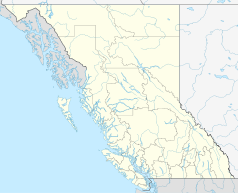Bamfield
| Bamfield | ||
|---|---|---|
 Bamfield |
||
| Location in British Columbia | ||
|
|
||
| State : |
|
|
| Province : | British Columbia | |
| Regional District : | Alberni-Clayoquot | |
| Coordinates : | 48 ° 50 ′ N , 125 ° 8 ′ W | |
| Area : | 4.87 km² | |
| Residents : | 179 (as of 2016) | |
| Population density : | 36.8 inhabitants / km² | |
| Time zone : | Pacific Time ( UTC − 8 ) | |
| Postal code : | V0R | |
| Bamfield East | ||||||||||||||||||||||||||||||||||||||||||||||||
|---|---|---|---|---|---|---|---|---|---|---|---|---|---|---|---|---|---|---|---|---|---|---|---|---|---|---|---|---|---|---|---|---|---|---|---|---|---|---|---|---|---|---|---|---|---|---|---|---|
| Climate diagram | ||||||||||||||||||||||||||||||||||||||||||||||||
| ||||||||||||||||||||||||||||||||||||||||||||||||
Bamfield is a place on the west coast of Vancouver Island in British Columbia , Canada , in the Alberni-Clayoquot Regional District . It is located at the southern entrance to Barkley Sound , an area that can be reached either by lake, from Port Alberni or Ucluelet , or via an 80 km logging road. In 2016 it had 179 inhabitants who lived in 160 households, with a community size of 4.87 km². The Huu-ay-aht resident in the area are one of seven Nuu-chah-nulth tribes that live on this sound.
The place is divided into Bamfield West, which is on the Mills Peninsula and can only be reached by water, and Bamfield East, which is on the other side of Bamfield Inlet. The latter lies between Bamfield Inlet and Grappler Inlet, at the end of which there is a small harbor (Port Desire).
history
In 1849 a shipbuilder named William Eddy Banfield left his ship to trade with the Indians in the Huu-ay-aht area. Around 1860, Banfield established a permanent trading post that later bore his name. In 1862 he died under unknown circumstances. Although a Huu-ay-aht was charged with murder, no guilt could be proven. There are many indications that he drowned while canoeing.
Diseases decimated the Huu-ay-aht to such an extent that they had to give up their main town, Kiix? In (Huu7ii). Some of the longhouses and stakes are still there today. The band hopes to turn the village into a “ heritage site ” and open it up to tourism. They are supported by the Historic Sites and Monuments Board of Canada . The 100 or so Huu-ay-aht live mostly in Pachena Bay . They are in the process of signing a contract with the Canadian government and the provincial government that will significantly enlarge their reservation, but at the same time privatize their property.
In 1902 Bamfield became the terminus of an undersea telegraph cable connecting the British part of North America with Australia . The first post office opened in 1903, but a spelling mistake by a government employee quickly turned Banfield into Bamfield - although the place is still on Banfield Inlet .
In 1959 the telegraph station closed after the cable was extended to Port Alberni . In 1972 the Bamfield Marine Sciences Center was opened in the former station, as well as a research center used by tourists. Tourism in Bamfield has so far been focused on fishing, kayaking and hiking (Bamfield is the northern starting point of the West Coast Trail , which stretches along the coast to Port Renfrew ), but is expanding to include cultural and historical areas.
population
The census in 2016 showed a population of 179 inhabitants for the municipality, after the census in 2011 still showed a population of 155 inhabitants for the municipality. The population has increased by 15.5% compared to the last census in 2011 and is thus well above the provincial average with a population increase in British Columbia of 5.6%. In the census period 2006 to 2011, contrary to the provincial trend, the number of inhabitants in the municipality decreased by 38.2%, while the provincial average increased by 7.0%. In 2016, 85 of the residents of the settlement were male and 70 female
For the 2016 census, a median age of 55.6 years was determined for the municipality . The median age of the province in 2016 was only 43.0 years. The median age was 51.8 years, or 42.3 years in the province. Only 2.8% of the residents were younger than 14 years, the number of children is significantly below the average for the province with a share of 14.9% there. The proportion of residents aged 65 and over is far above average (local: 27.8%; provincial: 18.3%). For the 2011 census, a median age of 45.9 years was determined for the municipality. The median age of the province in 2011 was only 41.9 years.
Of the approximately 250 inhabitants in the 2006 census, 190 stated that they had Native American ancestors, and 25 were members of a First Nation. Around 50 residents each spoke Spanish and Italian.
Web links
Remarks
- ^ A b Bamfield Community Profile. Census 2016. In: Statistics Canada . April 24, 2018, accessed September 20, 2018 .
- ^ A b Andrew Scott: The Encyclopedia of Raincoast Place Names: A Complete Reference to Coastal British Columbia . Harbor Publishing, Madeira Park, BC October 2009, p. 56 (English).
- ^ Bamfield Community Profile. Census 2011. In: Statistics Canada . May 31, 2016, accessed September 20, 2018 .
- ^ Bamfield Community Profile. Census 2006. In: Statistics Canada . June 12, 2010, accessed October 8, 2012 .
